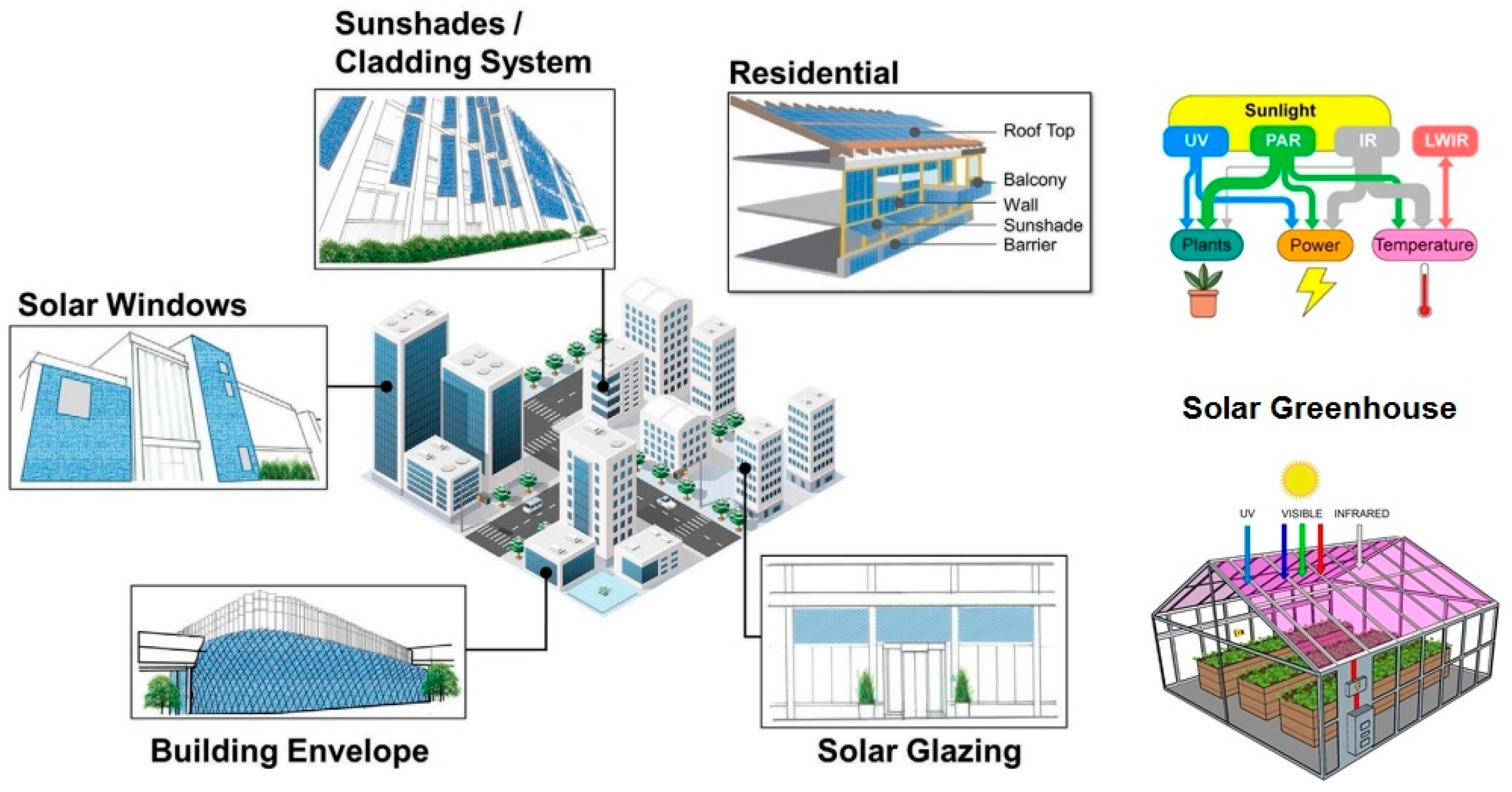Tackling Efficiency Challenges and Exploring Greenhouse-Integrated Organic Photovoltaics
Abstract
:1. Introduction
1.1. Evolution of Organic Solar Cell (OSC)
- Single-Layer OSC → In this layer of the OSC, a thin layer of organic semiconductor material is placed between two conducting layers called electrodes, with one layer that can allow the radiation to transmit. There are two types of active materials in the organic layer, such as an electron donor and electron acceptor. The organic layer serves both as an electron-donating and an electron-accepting layer. Single-layer OSCs typically exhibit low PCE because of their small exciton diffusion length and inefficient charge separation. In 1986, Tang et al. presented the first single-layer system using copper phthalocyanine as the active material [25].
- Bilayer OSC → Bilayer OSCs were developed to address the limitations of single-layer OSCs. These devices consist of double organic layers: one electron-donating material and one electron-accepting material stacked in a planar hetero-junction configuration [3]. This arrangement allows for the better separation of charges at the donor–acceptor interface, leading to higher efficiency than in single-layer OSCs. However, the diffusion length is still a restricting factor for the performance of these devices [25]. Bilayer OSCs demonstrate improved charge separation compared to single-layer devices but still suffer from limited exciton diffusion and sub-optimal donor–acceptor interfaces [26].
- Bulk Heterojunction (BHJ) OSC → A BHJ OSC is produced from the blending of electron-donating and electron-accepting materials, which creates an inter-penetrating network in the active layer. This network gives a greater interfacial region between the electron-donating material and electron-accepting material, facilitating good exciton dissociation and the separation of charges. In 1995, the idea of BHJ OSCs was first described by Yu et al., who used [6,6]-phenyl-C61-butyric acid methyl ester (PCBM) as an electron acceptor and poly(3-hexylthiophene) (P3HT) as an electron donor [27]. BHJ OSCs have become the most widely researched and promising OSC architectures due to their superior performance and potential for further optimization [28].
- Radiation absorption → when light is incident on the OSC, optical absorption is caused by the active material layer, which comprises donor and acceptor materials (for example, a P3HT and PCBM, respectively) [14]. Upon absorbing a specific wavelength of light compatible with the bandgap of the donor, an electron excites from one molecular energy level (such as HOMO) to another molecular energy level (such as LUMO) of the donor material, generating an excited state with excitons (pairs of holes and electrons) [18]
- Exciton generation and diffusion → excitons are bound pairs of electron–holes created upon light absorption [29]. They are mobile and can diffuse through the donor material. Generally, the exciton diffusion length in organic materials is approximately 10–20 nm, limiting the active layer’s thickness [30]. The morphology of the active materials has a vital role in facilitating the diffusion of excitons and charge separation [31].
- Charge collection → following charge separation, the excitons migrate through the active materials, to their corresponding electrodes [34]. The charge transport efficiency depends on factors such as the charge carrier’s mobility, the active layer’s morphology, and the presence of charge traps [35]. After the pairs of electrons and holes have migrated toward their respective electrodes, they are collected, generating an external current [36].
1.2. Objectives and Structure of the Research
- to discuss the dependency of the PCE on several parameters, such as the fill factor (FF), short circuit current density (Jsc), and open circuit voltage (Voc);
- to discuss the recent strategies to enhance the PCE, such as bandgap tuning, molecular orbital alignment, active layer morphology engineering, electron-donating and -withdrawing group incorporation, side chain length engineering, a third additive’s insertion, and control of the solubility of materials;
- to discuss recent advances in GIPV.
2. Power Conversion Efficiency (PCE)
2.1. Open Circuit Voltage (VOC)
2.2. Short Circuit Current Density (JSC)
2.3. Fill Factor (FF)
2.4. J-V Curve
3. Challenges and Strategies to Improve Efficiency
4. Greenhouse-Integrated Photovoltaics (GIPV)
5. International Green Initiatives
6. Discussion
7. Conclusions and Outlook
Author Contributions
Funding
Data Availability Statement
Conflicts of Interest
References
- Rockström, J.; Steffen, W.; Noone, K.; Persson, Å.; Chapin, F.S.; Lambin, E.F.; Lenton, T.M.; Scheffer, M.; Folke, C.; Schellnhuber, H.J. A safe operating space for humanity. Nature 2009, 461, 472–475. [Google Scholar] [CrossRef]
- Agency, I.E. World Energy Outlook 2020; OECD Publishing: Paris, France, 2020. [Google Scholar]
- Green, M.A.; Hishikawa, Y.; Dunlop, E.; Levi, D.; Hohl-Ebinger, J.; Yoshita, M.; Ho-Baillie, A. Solar cell efficiency tables (version 53) Progress in Photovoltaics. Res. Appl 2019, 27, 3–12. [Google Scholar]
- Brabec, C.; Scherf, U.; Dyakonov, V. Organic Photovoltaics: Materials, Device Physics, and Manufacturing Technologies; John Wiley & Sons: Hoboken, NJ, USA, 2011. [Google Scholar]
- Li, S.; Li, Z.; Wan, X.; Chen, Y. Recent progress in flexible organic solar cells. eScience 2023, 3, 100085. [Google Scholar] [CrossRef]
- Kaltenbrunner, M.; White, M.S.; Głowacki, E.D.; Sekitani, T.; Someya, T.; Sariciftci, N.S.; Bauer, S. Ultrathin and lightweight organic solar cells with high flexibility. Nat. Commun. 2012, 3, 770. [Google Scholar] [CrossRef] [PubMed]
- La Notte, L.; Giordano, L.; Calabrò, E.; Bedini, R.; Colla, G.; Puglisi, G.; Reale, A. Hybrid and organic photovoltaics for greenhouse applications. Appl. Energy 2020, 278, 115582. [Google Scholar] [CrossRef]
- Zhao, Y.; Zhu, Y.; Cheng, H.-W.; Zheng, R.; Meng, D.; Yang, Y. A review on semitransparent solar cells for agricultural application. Mater. Today Energy 2021, 22, 100852. [Google Scholar] [CrossRef]
- Traverse, C.J.; Pandey, R.; Barr, M.C.; Lunt, R.R. Emergence of highly transparent photovoltaics for distributed applications. Nat. Energy 2017, 2, 849–860. [Google Scholar] [CrossRef]
- Ravishankar, E.; Booth, R.E.; Saravitz, C.; Sederoff, H.; Ade, H.W.; O’Connor, B.T. Achieving net zero energy greenhouses by integrating semitransparent organic solar cells. Joule 2020, 4, 490–506. [Google Scholar] [CrossRef]
- Ravishankar, E.; Charles, M.; Xiong, Y.; Henry, R.; Swift, J.; Rech, J.; Calero, J.; Cho, S.; Booth, R.E.; Kim, T. Balancing crop production and energy harvesting in organic solar-powered greenhouses. Cell Rep. 2021, 2, 100381. [Google Scholar]
- Ravishankar, E.; Booth, R.E.; Hollingsworth, J.A.; Ade, H.; Sederoff, H.; DeCarolis, J.F.; O’Connor, B.T. Organic solar powered greenhouse performance optimization and global economic opportunity. Energy Environ. Sci. 2022, 15, 1659–1671. [Google Scholar] [CrossRef]
- Koh, T.M.; Wang, H.; Ng, Y.F.; Bruno, A.; Mhaisalkar, S.; Mathews, N.J.A.M. Halide perovskite solar cells for building integrated photovoltaics: Transforming building façades into power generators. Adv. Mater. 2022, 34, 2104661. [Google Scholar] [CrossRef] [PubMed]
- Li, G.; Zhu, R.; Yang, Y. Polymer solar cells. Nat. Photon. 2012, 6, 153–161. [Google Scholar] [CrossRef]
- Dang, M.T.; Hirsch, L.; Wantz, G. P3HT: PCBM, best seller in polymer photovoltaic research. Adv. Mater. 2011, 23, 3597–3602. [Google Scholar] [CrossRef] [PubMed]
- Søndergaard, R.R.; Hösel, M.; Krebs, F.C. Roll-to-Roll fabrication of large area functional organic materials. J. Polym. Sci. B Polym. 2013, 51, 16–34. [Google Scholar] [CrossRef]
- Kim, J.Y.; Kim, S.H.; Lee, H.H.; Lee, K.; Ma, W.; Gong, X.; Heeger, A.J. New architecture for high-efficiency polymer photovoltaic cells using solution-based titanium oxide as an optical spacer. Adv. Mater. 2006, 18, 572–576. [Google Scholar] [CrossRef]
- Park, S.H.; Roy, A.; Beaupré, S.; Cho, S.; Coates, N.; Moon, J.S.; Moses, D.; Leclerc, M.; Lee, K.; Heeger, A.J. Bulk heterojunction solar cells with internal quantum efficiency approaching 100%. Nat. Photon. 2009, 3, 297–302. [Google Scholar] [CrossRef]
- Song, W.; Fanady, B.; Peng, R.; Hong, L.; Wu, L.; Zhang, W.; Yan, T.; Wu, T.; Chen, S.; Ge, Z. Foldable semitransparent organic solar cells for photovoltaic and photosynthesis. Adv. Energy Mater. 2020, 10, 2000136. [Google Scholar] [CrossRef]
- Mishra, K.; Stanghellini, C.; Hemming, S. Technology and Materials for Passive Manipulation of the Solar Spectrum in Greenhouses. Adv. Sustain. Syst. 2023, 7, 2200503. [Google Scholar] [CrossRef]
- Betancur, R.; Romero-Gomez, P.; Martinez-Otero, A.; Elias, X.; Maymó, M.; Martorell, J. Transparent polymer solar cells employing a layered light-trapping architecture. Nat. Photon. 2013, 7, 995–1000. [Google Scholar] [CrossRef]
- Ercilla-Montserrat, M.; Izquierdo, R.; Belmonte, J.; Montero, J.I.; Muñoz, P.; De Linares, C.; Rieradevall, J. Building-integrated agriculture: A first assessment of aerobiological air quality in rooftop greenhouses (i-RTGs). Sci. Total Environ. 2017, 598, 109–120. [Google Scholar] [CrossRef]
- Jelle, B.P. Building integrated photovoltaics: A concise description of the current state of the art and possible research pathways. Energies 2015, 9, 21. [Google Scholar] [CrossRef]
- Brabec, C.J. Organic photovoltaics: Technology and market. Sol. Energy Mater Sol. Cells 2004, 83, 273–292. [Google Scholar] [CrossRef]
- Tang, C.W. Two-layer organic photovoltaic cell. Appl. Phys. Lett. 1986, 48, 183–185. [Google Scholar] [CrossRef]
- Kippelen, B.; Brédas, J.-L. Organic photovoltaics. Energy Environ. Sci. 2009, 2, 251–261. [Google Scholar] [CrossRef]
- Yu, G.; Gao, J.; Hummelen, J.C.; Wudl, F.; Heeger, A.J. Polymer photovoltaic cells: Enhanced efficiencies via a network of internal donor-acceptor heterojunctions. Science 1995, 270, 1789–1791. [Google Scholar] [CrossRef]
- Liao, H.-C.; Ho, C.-C.; Chang, C.-Y.; Jao, M.-H.; Darling, S.B.; Su, W.-F. Additives for morphology control in high-efficiency organic solar cells. Mater. Today 2013, 16, 326–336. [Google Scholar] [CrossRef]
- Clarke, T.M.; Durrant, J.R. Charge photogeneration in organic solar cells. Chem. Rev. 2010, 110, 6736–6767. [Google Scholar] [CrossRef]
- Lunt, R.R.; Bulovic, V. Transparent, near-infrared organic photovoltaic solar cells for window and energy-scavenging applications. Appl. Phys. Lett. 2011, 98, 61. [Google Scholar] [CrossRef]
- Scharber, M.C.; Sariciftci, N.S. Efficiency of bulk-heterojunction organic solar cells. Prog. Polym. Sci. 2013, 38, 1929–1940. [Google Scholar] [CrossRef]
- Vandewal, K.; Albrecht, S.; Hoke, E.T.; Graham, K.R.; Widmer, J.; Douglas, J.D.; Schubert, M.; Mateker, W.R.; Bloking, J.T.; Burkhard, G.F. Efficient charge generation by relaxed charge-transfer states at organic interfaces. Nat. Mater. 2014, 13, 63–68. [Google Scholar] [CrossRef]
- Liu, J.; Chen, S.; Qian, D.; Gautam, B.; Yang, G.; Zhao, J.; Bergqvist, J.; Zhang, F.; Ma, W.; Ade, H. Fast charge separation in a non-fullerene organic solar cell with a small driving force. Nat. Energy 2016, 1, 1–7. [Google Scholar] [CrossRef]
- He, Z.; Zhong, C.; Su, S.; Xu, M.; Wu, H.; Cao, Y. Enhanced power-conversion efficiency in polymer solar cells using an inverted device structure. Nat. Photon. 2012, 6, 591–595. [Google Scholar] [CrossRef]
- Nielsen, C.B.; Turbiez, M.; McCulloch, I. Recent advances in the development of semiconducting DPP-containing polymers for transistor applications. Adv. Mater. 2013, 25, 1859–1880. [Google Scholar] [CrossRef] [PubMed]
- Ameri, T.; Dennler, G.; Lungenschmied, C.; Brabec, C.J. Organic tandem solar cells: A review. Energy Environ. Sci. 2009, 2, 347–363. [Google Scholar] [CrossRef]
- Xu, T.; Qiao, Q. Organic Photovoltaics: Basic Concepts and Device Physics. In Encyclopedia of Nanotechnology; Bhushan, B., Ed.; Springer: Dordrecht, The Netherlands, 2012; pp. 2022–2031. [Google Scholar]
- Widmer, J.; Tietze, M.; Leo, K.; Riede, M. Open-circuit voltage and effective gap of organic solar cells. Adv. Funct. Mater. 2013, 23, 5814–5821. [Google Scholar] [CrossRef]
- Petrus, M.L. Azomethine-based Donor Materials for Organic Solar Cells; Delft University of Technology: Delft, The Netherlands, 2014. [Google Scholar]
- Green, M.; Dunlop, E.; Hohl-Ebinger, J.; Yoshita, M.; Kopidakis, N.; Hao, X. Solar cell efficiency tables (version 57). Prog. Photovolt. 2021, 29, 3–15. [Google Scholar] [CrossRef]
- Jin, J.; Wang, Q.; Ma, K.; Shen, W.; Belfiore, L.A.; Bao, X.; Tang, J. Recent developments of polymer solar cells with photovoltaic performance over 17%. Adv. Funct. Mater. 2023, 33, 2213324. [Google Scholar] [CrossRef]
- Zhang, B.; Yang, F.; Li, Y.J.S.S. Recent Progress in Large-Area Organic Solar Cells. Small Sci. 2023, 3, 2300004. [Google Scholar] [CrossRef]
- Xu, X.; Li, D.; Yuan, J.; Zhou, Y.; Zou, Y. Recent advances in stability of organic solar cells. EnergyChem 2021, 3, 100046. [Google Scholar] [CrossRef]
- Rodríguez-Martínez, X.; Riera-Galindo, S.; Aguirre, L.E.; Campoy-Quiles, M.; Arwin, H.; Inganäs, O. Laminated Organic Photovoltaic Modules for Agrivoltaics and Beyond: An Outdoor Stability Study of All-Polymer and Polymer: Small Molecule Blends. Adv. Funct. Mater. 2023, 33, 2213220. [Google Scholar] [CrossRef]
- Duan, L.; Uddin, A. Progress in stability of organic solar cells. Advanced Science 2020, 7, 1903259. [Google Scholar] [CrossRef] [PubMed]
- Mai, T.L.H.; Jeong, S.; Kim, S.; Jung, S.; Oh, J.; Sun, Z.; Park, J.; Lee, S.; Kim, W.; Yang, C. Over 18.2%-Efficiency Organic Solar Cells with Exceptional Device Stability Enabled by Bay-Area Benzamide-Functionalized Perylene Diimide Interlayer. Adv. Funct. Mater. 2023, 2303386. [Google Scholar] [CrossRef]
- Li, Z.; Jiang, C.; Chen, X.; Song, G.; Wan, X.; Kan, B.; Duan, T.; Knyazeva, E.A.; Rakitin, O.A.; Chen, Y. Side-chain modification of non-fullerene acceptors for organic solar cells with efficiency over 18%. J. Mater. Chem. C 2023, 11, 6920–6927. [Google Scholar] [CrossRef]
- Kong, T.; Yang, G.; Fan, P.; Yu, J. Solution-Processable NiOx: PMMA Hole Transport Layer for Efficient and Stable Inverted Organic Solar Cells. Polymers 2023, 15, 1875. [Google Scholar] [CrossRef]
- Li, C.-P.; Yang, C.-S.; Chen, P.-C.; Hsu, F.-C. Stability improvement of inverted organic solar cells with thin organic protective layer. Org. Electron. 2022, 108, 106602. [Google Scholar] [CrossRef]
- Park, N.-G. Organometal perovskite light absorbers toward a 20% efficiency low-cost solid-state mesoscopic solar cell. J. Phys. Chem. Lett. 2013, 4, 2423–2429. [Google Scholar] [CrossRef]
- Brabec, C.J.; Heeney, M.; McCulloch, I.; Nelson, J. Influence of blend microstructure on bulk heterojunction organic photovoltaic performance. Chem. Soc. Rev. 2011, 40, 1185–1199. [Google Scholar] [CrossRef]
- Tarique, W.B.; Uddin, A. A review of progress and challenges in the research developments on organic solar cells. Mater. Sci. Semicond. 2023, 163, 107541. [Google Scholar] [CrossRef]
- Mihailetchi, V.; Koster, L.; Blom, P. Effect of metal electrodes on the performance of polymer: Fullerene bulk heterojunction solar cells. Appl. Phys. Lett. 2004, 85, 970–972. [Google Scholar] [CrossRef]
- Zhao, F.; Zhang, H.; Zhang, R.; Yuan, J.; He, D.; Zou, Y.; Gao, F. Emerging approaches in enhancing the efficiency and stability in non-fullerene organic solar cells. Adv. Energy Mater. 2020, 10, 2002746. [Google Scholar] [CrossRef]
- Yang, W.; Luo, Z.; Sun, R.; Guo, J.; Wang, T.; Wu, Y.; Wang, W.; Guo, J.; Wu, Q.; Shi, M. Simultaneous enhanced efficiency and thermal stability in organic solar cells from a polymer acceptor additive. Nat. Commun. 2020, 11, 1218. [Google Scholar] [CrossRef] [PubMed]
- Zheng, Z.; Wang, J.; Bi, P.; Ren, J.; Wang, Y.; Yang, Y.; Liu, X.; Zhang, S.; Hou, J. Tandem organic solar cell with 20.2% efficiency. Joule 2022, 6, 171–184. [Google Scholar] [CrossRef]
- Best Research-Cell Efficiency Chart. Available online: https://www.nrel.gov/pv/cell-efficiency.html (accessed on 9 July 2023).
- Zhou, H.; Yang, L.; Stuart, A.C.; Price, S.C.; Liu, S.; You, W. Development of fluorinated benzothiadiazole as a structural unit for a polymer solar cell of 7% efficiency. Angew. Chem., Int. Ed. 2011, 50, 2995–2998. [Google Scholar] [CrossRef] [PubMed]
- Su, N.; Chen, J.; Peng, M.; Li, G.; Pankow, R.M.; Zheng, D.; Ding, J.; Facchetti, A.; Marks, T.J. π-Extension and chlorination of non-fullerene acceptors enable more readily processable and sustainable high-performance organic solar cells. J. Energy Chem. 2023, 79, 321–329. [Google Scholar] [CrossRef]
- Li, G.; Feng, L.-W.; Mukherjee, S.; Jones, L.O.; Jacobberger, R.M.; Huang, W.; Young, R.M.; Pankow, R.M.; Zhu, W.; Lu, N. Non-fullerene acceptors with direct and indirect hexa-fluorination afford> 17% efficiency in polymer solar cells. Energy Environ. Sci. 2022, 15, 645–659. [Google Scholar] [CrossRef]
- Li, G.; Zhang, X.; Jones, L.O.; Alzola, J.M.; Mukherjee, S.; Feng, L.-w.; Zhu, W.; Stern, C.L.; Huang, W.; Yu, J. Systematic merging of nonfullerene acceptor π-extension and tetrafluorination strategies affords polymer solar cells with >16% efficiency. J. Am. Chem. Soc. 2021, 143, 6123–6139. [Google Scholar] [CrossRef]
- Cheng, P.; Yang, Y. Narrowing the band gap: The key to high-performance organic photovoltaics. Acc. Chem. Res. 2020, 53, 1218–1228. [Google Scholar] [CrossRef]
- Liu, Q.; Jiang, Y.; Jin, K.; Qin, J.; Xu, J.; Li, W.; Xiong, J.; Liu, J.; Xiao, Z.; Sun, K.; et al. 18% Efficiency organic solar cells. Sci. Bull. 2020, 65, 272–275. [Google Scholar] [CrossRef] [PubMed]
- Scharber, M.C.; Mühlbacher, D.; Koppe, M.; Denk, P.; Waldauf, C.; Heeger, A.J.; Brabec, C.J. Design rules for donors in bulk-heterojunction solar cells—Towards 10% energy-conversion efficiency. Adv. Mater. Technol. 2006, 18, 789–794. [Google Scholar] [CrossRef]
- Scharber, M.C.; Sariciftci, N.S. Low band gap conjugated semiconducting polymers. Adv. Mater. Technol. 2021, 6, 2000857. [Google Scholar] [CrossRef]
- Ansari, M.A.; Mohiuddin, S.; Kandemirli, F.; Malik, M.I.J.R.a. Synthesis and characterization of poly (3-hexylthiophene): Improvement of regioregularity and energy band gap. RSC Adv. 2018, 8, 8319–8328. [Google Scholar] [CrossRef] [PubMed]
- Sajjad, M.T.; Ruseckas, A.; Samuel, I.D. Enhancing exciton diffusion length provides new opportunities for organic photovoltaics. Matter 2020, 3, 341–354. [Google Scholar] [CrossRef]
- Po, R.; Bernardi, A.; Calabrese, A.; Carbonera, C.; Corso, G.; Pellegrino, A. From lab to fab: How must the polymer solar cell materials design change?–an industrial perspective. Energy Environ. Sci. 2014, 7, 925–943. [Google Scholar] [CrossRef]
- Vandewal, K.; Tvingstedt, K.; Gadisa, A.; Inganäs, O.; Manca, J.V. On the origin of the open-circuit voltage of polymer–fullerene solar cells. Nat. Mater. 2009, 8, 904–909. [Google Scholar] [CrossRef] [PubMed]
- Vandewal, K.; Ma, Z.; Bergqvist, J.; Tang, Z.; Wang, E.; Henriksson, P.; Tvingstedt, K.; Andersson, M.R.; Zhang, F.; Inganäs, O. Quantification of Quantum efficiency and energy losses in low bandgap polymer: Fullerene solar cells with high open-circuit voltage. Adv. Funct. Mater. 2012, 22, 3480–3490. [Google Scholar] [CrossRef]
- Li, X.e.; Zhang, Q.; Yu, J.; Xu, Y.; Zhang, R.; Wang, C.; Zhang, H.; Fabiano, S.; Liu, X.; Hou, J. Mapping the energy level alignment at donor/acceptor interfaces in non-fullerene organic solar cells. Nat. Commun. 2022, 13, 2046. [Google Scholar] [CrossRef] [PubMed]
- Zhang, J.; Liu, W.; Zhang, M.; Liu, Y.; Zhou, G.; Xu, S.; Zhang, F.; Zhu, H.; Liu, F.; Zhu, X. Revealing the critical role of the HOMO alignment on maximizing current extraction and suppressing energy loss in organic solar cells. IScience 2019, 19, 883–893. [Google Scholar] [CrossRef] [PubMed]
- Chen, Q.; Huang, H.; Hu, D.; Zhang, C.e.; Xu, X.; Lu, H.; Wu, Y.; Yang, C.; Bo, Z.J.A.M. Improving the Performance of Layer-by-Layer Processed Organic Solar Cells via Introducing a Wide-Bandgap Dopant into the Upper Acceptor Layer. Adv. Mater. 2023, 35, 2211372. [Google Scholar] [CrossRef]
- Weng, K.; Ye, L.; Zhu, L.; Xu, J.; Zhou, J.; Feng, X.; Lu, G.; Tan, S.; Liu, F.; Sun, Y. Optimized active layer morphology toward efficient and polymer batch insensitive organic solar cells. Nat. Commun. 2020, 11, 2855. [Google Scholar] [CrossRef]
- Hoppe, H.; Sariciftci, N.S. Organic solar cells: An overview. J. Mater. Res. 2004, 19, 1924–1945. [Google Scholar] [CrossRef]
- Tian, L.; Xue, Q.; Hu, Z.; Huang, F. Recent advances of interface engineering for non-fullerene organic solar cells. Org. Electron. 2021, 93, 106141. [Google Scholar] [CrossRef]
- Barrau, S.; Andersson, V.; Zhang, F.; Masich, S.; Bijleveld, J.; Andersson, M.R.; Inganäs, O. Nanomorphology of bulk heterojunction organic solar cells in 2D and 3D correlated to photovoltaic performance. Macromolecules 2009, 42, 4646–4650. [Google Scholar] [CrossRef]
- Sun, R.; Guo, J.; Wu, Q.; Zhang, Z.; Yang, W.; Guo, J.; Shi, M.; Zhang, Y.; Kahmann, S.; Ye, L. A multi-objective optimization-based layer-by-layer blade-coating approach for organic solar cells: Rational control of vertical stratification for high performance. Energy Environ. Sci. 2019, 12, 3118–3132. [Google Scholar] [CrossRef]
- Sharma, R.; Lee, H.; Seifrid, M.; Gupta, V.; Bazan, G.C.; Yoo, S. Performance enhancement of conjugated polymer-small molecule-non fullerene ternary organic solar cells by tuning recombination kinetics and molecular ordering. Sol. Energy 2020, 201, 499–507. [Google Scholar] [CrossRef]
- El-naggar, A.; Alsaggaf, A.; Heiba, Z.K.; Kamal, A.; Aldhafiri, A.; Fatehmulla, A.; Mohamed, M.B. Exploring the structural, optical and electrical characteristics of PVA/PANi blends. Opt. Mater. 2023, 139, 113771. [Google Scholar] [CrossRef]
- Wang, Q.; Ma, K.; Wang, D.; Jin, J.; Liang, Y.; Shen, W.; Belfiore, L.A.; Tang, J. Morphology manipulation of photoactive layer through block copolymer to improve the photovoltaic performances of polymer solar cells. Mater. Sci. Eng. B. 2023, 297, 116685. [Google Scholar] [CrossRef]
- Shen, W.; Zhao, G.; Zhang, X.; Bu, F.; Yun, J.; Tang, J. Using dual microresonant cavity and plasmonic effects to enhance the photovoltaic efficiency of flexible polymer solar cells. Nanomaterials 2020, 10, 944. [Google Scholar] [CrossRef]
- Hou, J.; Chen, H.-Y.; Zhang, S.; Li, G.; Yang, Y. Synthesis, characterization, and photovoltaic properties of a low band gap polymer based on silole-containing polythiophenes and 2, 1, 3-benzothiadiazole. J. Am. Chem. Soc. 2008, 130, 16144–16145. [Google Scholar] [CrossRef]
- Luponosov, Y.N.; Min, J.; Solodukhin, A.N.; Kozlov, O.V.; Obrezkova, M.A.; Peregudova, S.M.; Ameri, T.; Chvalun, S.N.; Pshenichnikov, M.S.; Brabec, C.J. Effects of electron-withdrawing group and electron-donating core combinations on physical properties and photovoltaic performance in D-π-A star-shaped small molecules. Org. Electron. 2016, 32, 157–168. [Google Scholar] [CrossRef]
- Sutradhar, T.; Misra, A. Role of electron-donating and electron-withdrawing groups in tuning the optoelectronic properties of difluoroboron–napthyridine analogues. J. Phys. Chem. A 2018, 122, 4111–4120. [Google Scholar] [CrossRef]
- Lee, J.K.; Ma, W.L.; Brabec, C.J.; Yuen, J.; Moon, J.S.; Kim, J.Y.; Lee, K.; Bazan, G.C.; Heeger, A.J. Processing additives for improved efficiency from bulk heterojunction solar cells. J. Am. Chem. Soc. 2008, 130, 3619–3623. [Google Scholar] [CrossRef] [PubMed]
- Yuan, X.; Zhao, Y.; Xie, D.; Pan, L.; Liu, X.; Duan, C.; Huang, F.; Cao, Y.-L. Polythiophenes for organic solar cells with efficiency surpassing 17%. Joule 2022, 6, 647–661. [Google Scholar] [CrossRef]
- Yuan, X.; Zhao, Y.; Zhang, Y.; Xie, D.; Deng, W.; Li, J.; Wu, H.; Duan, C.; Huang, F.; Cao, Y.-L. Achieving 16% Efficiency for Polythiophene Organic Solar Cells with a Cyano-Substituted Polythiophene. Adv. Funct. Mater. 2022, 32, 2201142. [Google Scholar] [CrossRef]
- Zhang, S.; Ye, L.; Zhao, W.; Yang, B.; Wang, Q.; Hou, J. Realizing over 10% efficiency in polymer solar cell by device optimization. Sci. China Chem. 2015, 58, 248–256. [Google Scholar] [CrossRef]
- Zhang, S.; Ye, L.; Zhao, W.; Liu, D.; Yao, H.; Hou, J. Side chain selection for designing highly efficient photovoltaic polymers with 2D-conjugated structure. Macromolecules 2014, 47, 4653–4659. [Google Scholar] [CrossRef]
- Gadisa, A.; Oosterbaan, W.D.; Vandewal, K.; Bolsée, J.C.; Bertho, S.; D’Haen, J.; Lutsen, L.; Vanderzande, D.; Manca, J.V. Effect of Alkyl Side-Chain Length on Photovoltaic Properties of Poly (3-alkylthiophene)/PCBM Bulk Heterojunctions. Adv. Funct. Mater. 2009, 19, 3300–3306. [Google Scholar] [CrossRef]
- Liu, T.; Pan, X.; Meng, X.; Liu, Y.; Wei, D.; Ma, W.; Huo, L.; Sun, X.; Lee, T.H.; Huang, M. Alkyl side-chain engineering in wide-bandgap copolymers leading to power conversion efficiencies over 10%. Adv. Mater. 2017, 29, 1604251. [Google Scholar] [CrossRef]
- Guo, J.; Hu, K.; Qiu, B.; Zhang, J.; Yang, D.; Zhou, L.; Li, S.; Meng, L.; Zhang, Z.; Li, Y. Fine-Tuning Miscibility and π–π Stacking by Alkylthio Side Chains of Donor Molecules Enables High-Performance All-Small-Molecule Organic Solar Cells. ACS Appl. Mater. Interfaces 2021, 13, 36033–36043. [Google Scholar] [CrossRef]
- Ge, J.; Chen, Z.; Ye, Q.; Xie, L.; Song, W.; Guo, Y.; Zhang, J.; Tong, X.; Zhang, J.; Zhou, E. Modulation of Molecular Stacking via Tuning 2-Ethylhexyl Alkyl Chain Enables Improved Efficiency for All-Small-Molecule Organic Solar Cells. ACS Appl. Mater. Interfaces 2023, 15, 10803–10811. [Google Scholar] [CrossRef]
- Luo, D.; Jiang, Z.; Shan, C.; Li, L.; Duan, C.; Liu, Q.; Wang, Z.; Wang, K.; Xu, B.; Kyaw, A.K.K. Simultaneous Tuning of Alkyl Chains and End Groups in Non-fused Ring Electron Acceptors for Efficient and Stable Organic Solar Cells. ACS Appl. Mater. Interfaces 2022, 14, 24374–24385. [Google Scholar] [CrossRef]
- Li, Y.; Huang, W.; Zhao, D.; Wang, L.; Jiao, Z.; Huang, Q.; Wang, P.; Sun, M.; Yuan, G. Recent Progress in Organic Solar Cells: A Review on Materials from Acceptor to Donor. Molecules 2022, 27, 1800. [Google Scholar] [CrossRef]
- Lu, L.; Xu, T.; Chen, W.; Landry, E.S.; Yu, L. Ternary blend polymer solar cells with enhanced power conversion efficiency. Nat. Photon. 2014, 8, 716–722. [Google Scholar] [CrossRef]
- Liu, X.; Peng, Y.; Liang, Z.; Wang, L.; Han, S.; Dou, Z.; Lu, X.; Tong, J.; Liu, J.; Li, J. Efficient ternary organic photovoltaic device with a non-halogenated solvent via synergistic inhibiting charge recombination and regulating morphology. J. Mater. Chem. C 2023, 11, 2871–2879. [Google Scholar] [CrossRef]
- Benanti, T.L.; Venkataraman, D. Organic solar cells: An overview focusing on active layer morphology. Photosynth. Res. 2006, 87, 73–81. [Google Scholar] [CrossRef] [PubMed]
- Jiang, M.; Bai, H.-r.; Zhi, H.-f.; Sun, J.-k.; Wang, J.-l.; Zhang, F.; An, Q. Two-pronged effect of warm solution and solvent-vapor annealing for efficient and stable all-small-molecule organic solar cells. ACS Energy Lett. 2021, 6, 2898–2906. [Google Scholar] [CrossRef]
- Zhou, X.-j.; Dai, T.-t.; Li, X.; Yan, Y.-j.; Xiong, W.; Lin, T.; Zhou, J.; Xu, D.-h.; Zhu, Y.-h.; Zhao, J. Improved Charge Transport and Reduced Carrier Recombination of Nonfullerene Organic Solar Cells with the Binary Solvent. ACS Appl. Energy Mater. 2021, 4, 8175–8182. [Google Scholar] [CrossRef]
- Espinosa, N.; Hösel, M.; Angmo, D.; Krebs, F.C. Solar cells with one-day energy payback for the factories of the future. Energy Environ. Sci. 2012, 5, 5117–5132. [Google Scholar] [CrossRef]
- Foley, J.A.; Ramankutty, N.; Brauman, K.A.; Cassidy, E.S.; Gerber, J.S.; Johnston, M.; Mueller, N.D.; O’Connell, C.; Ray, D.K.; West, P.C. Solutions for a cultivated planet. Nature 2011, 478, 337–342. [Google Scholar] [CrossRef]
- Lages Barbosa, G.; Almeida Gadelha, F.D.; Kublik, N.; Proctor, A.; Reichelm, L.; Weissinger, E.; Wohlleb, G.M.; Halden, R.U. Comparison of land, water, and energy requirements of lettuce grown using hydroponic vs. conventional agricultural methods. Int. J. Environ. Res. Public Health 2015, 12, 6879–6891. [Google Scholar] [CrossRef]
- Albright, L.D. Environment Control for Animals and Plants; American Society of Agricultural Engineers: St. Joseph, MI, USA, 1990. [Google Scholar]
- Liu, Y.; Cheng, P.; Li, T.; Wang, R.; Li, Y.; Chang, S.-Y.; Zhu, Y.; Cheng, H.-W.; Wei, K.-H.; Zhan, X. Unraveling sunlight by transparent organic semiconductors toward photovoltaic and photosynthesis. ACS nano 2019, 13, 1071–1077. [Google Scholar] [CrossRef]
- Ho, C.H.Y.; Kim, T.; Xiong, Y.; Firdaus, Y.; Yi, X.; Dong, Q.; Rech, J.J.; Gadisa, A.; Booth, R.; O’Connor, B.T. High-Performance Tandem Organic Solar Cells Using HSolar as the Interconnecting Layer. Adv. Energy Mater. 2020, 10, 2000823. [Google Scholar] [CrossRef]
- Hu, Z.; Wang, J.; Wang, Z.; Gao, W.; An, Q.; Zhang, M.; Ma, X.; Wang, J.; Miao, J.; Yang, C. Semitransparent ternary nonfullerene polymer solar cells exhibiting 9.40% efficiency and 24.6% average visible transmittance. Nano Energy 2019, 55, 424–432. [Google Scholar] [CrossRef]
- Zang, Y.; Chen, L.; Zhou, J.; Xu, R.; Liu, Z. Enhanced light utilization in semitransparent organic solar cells based on a nonfullerene acceptor of IEICO-4F. Appl. Phys. A 2021, 127, 1–11. [Google Scholar] [CrossRef]
- Wang, D.; Liu, H.; Li, Y.; Zhou, G.; Zhan, L.; Zhu, H.; Lu, X.; Chen, H.; Li, C.Z. High-performance and eco-friendly semitransparent organic solar cells for greenhouse applications. Joule 2021, 5, 945–957. [Google Scholar] [CrossRef]
- Zisis, C.; Pechlivani, E.M.; Tsimikli, S.; Mekeridis, E.; Laskarakis, A.; Logothetidis, S. Organic Photovoltaics on Greenhouse Rooftops: Effects on Plant Growth. Mater. Today: Proc. 2019, 19, 65–72. [Google Scholar] [CrossRef]
- Kini, G.P.; Jeon, S.J.; Moon, D.K. Latest Progress on Photoabsorbent Materials for Multifunctional Semitransparent Organic Solar Cells. Adv. Funct. Mater. 2021, 31, 2007931. [Google Scholar] [CrossRef]
- Jinnai, S.; Oi, A.; Seo, T.; Moriyama, T.; Terashima, M.; Suzuki, M.; Nakayama, K.-i.; Watanabe, Y.; Ie, Y. Green-Light Wavelength-Selective Organic Solar Cells Based on Poly (3-hexylthiophene) and Naphthobisthiadiazole-Containing Acceptors toward Agrivoltaics. ACS Sustain. Chem. Eng. 2023, 11, 1548–1556. [Google Scholar] [CrossRef]
- Sustainable Development Goals. Available online: https://sdgs.un.org/goals (accessed on 7 August 2023).
- The Paris Agreement. In Proceedings of the Report of the Conference of the Parties to the United Nations Framework Convention on Climate Change, Paris, France, 30 November–12 December 2015; 21st session, Retrived December, 2015. p. 2017.
- A European Green Deal. Available online: https://commission.europa.eu/strategy-and-policy/priorities-2019-2024/european-green-deal_en (accessed on 8 July 2023).
- Obaideen, K.; Olabi, A.G.; Al Swailmeen, Y.; Shehata, N.; Abdelkareem, M.A.; Alami, A.H.; Rodriguez, C.; Sayed, E.T. Solar energy: Applications, trends analysis, bibliometric analysis and research contribution to sustainable development goals (SDGs). Sustainability 2023, 15, 1418. [Google Scholar] [CrossRef]
- Chatzipanagi, A.; Taylor, N.; Jaeger-Waldau, A. Overview of the Potential and Challenges for Agri-Photovoltaics in the European Union; Publications Office of the European Union: Luxembourg, 2023. [Google Scholar]
- Gomez-Casanovas, N.; Mwebaze, P.; Khanna, M.; Branham, B.; Time, A.; DeLucia, E.H.; Bernacchi, C.J.; Knapp, A.K.; Hoque, M.J.; Du, X.; et al. Knowns, uncertainties, and challenges in agrivoltaics to sustainably intensify energy and food production. Cell Rep. Phys. Sci. 2023, 101518. [Google Scholar] [CrossRef]

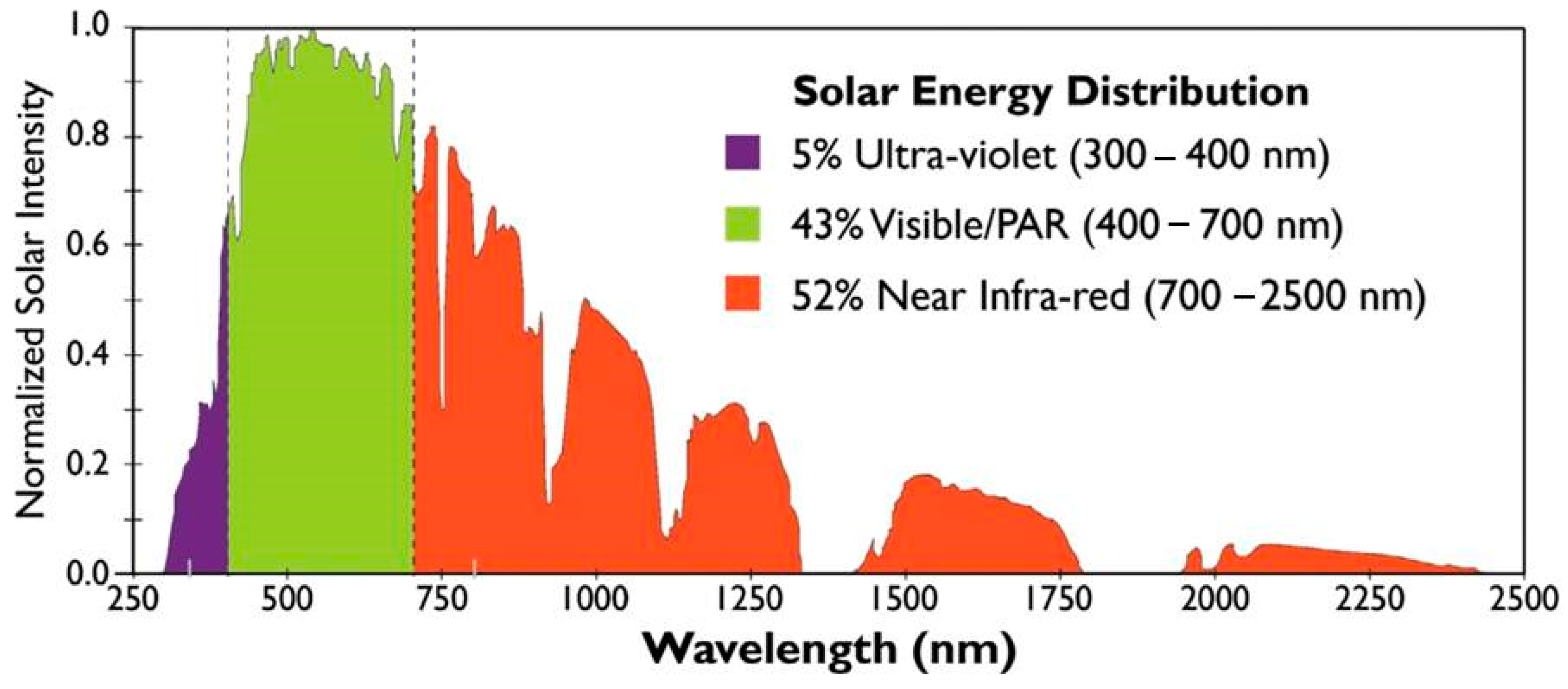
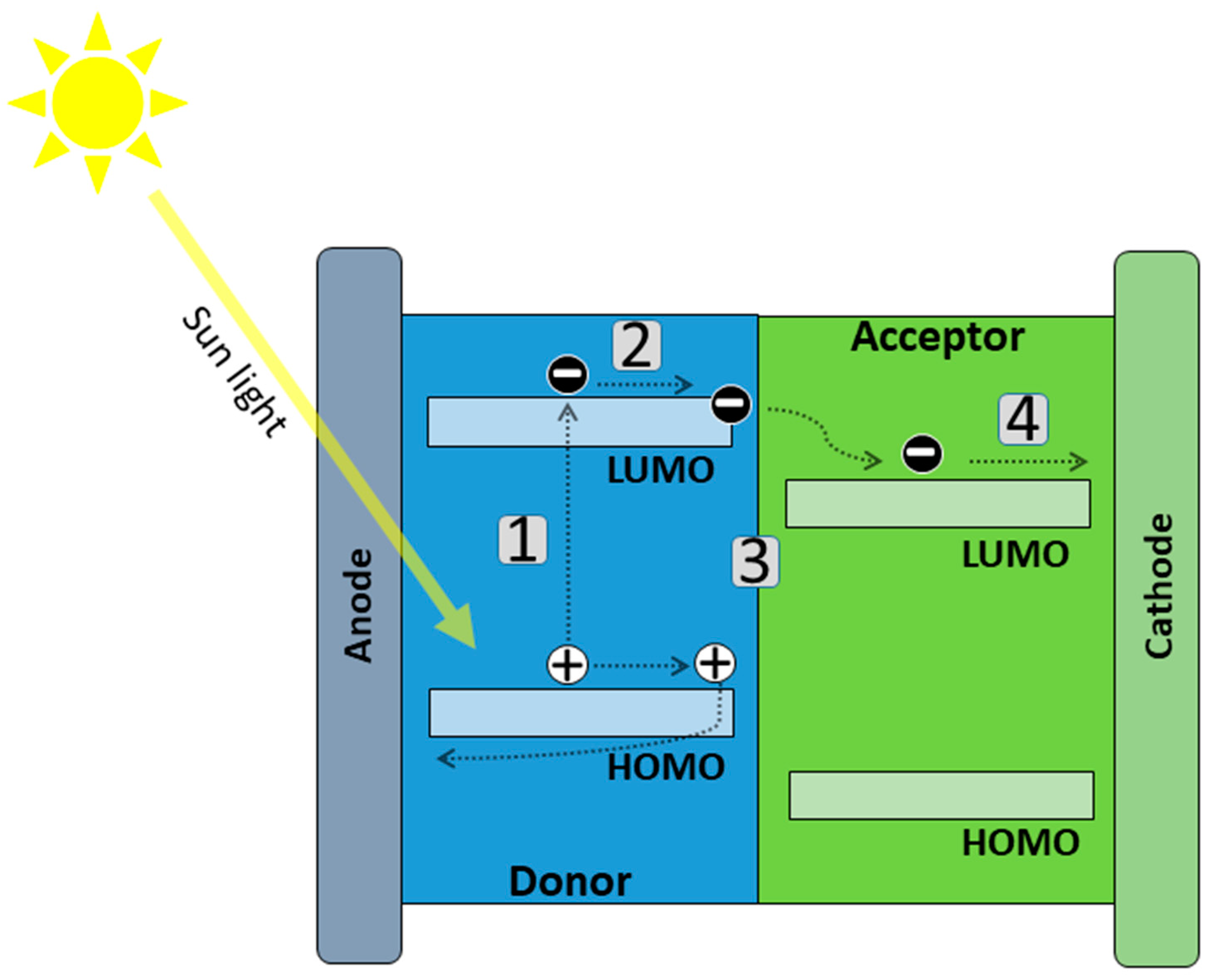


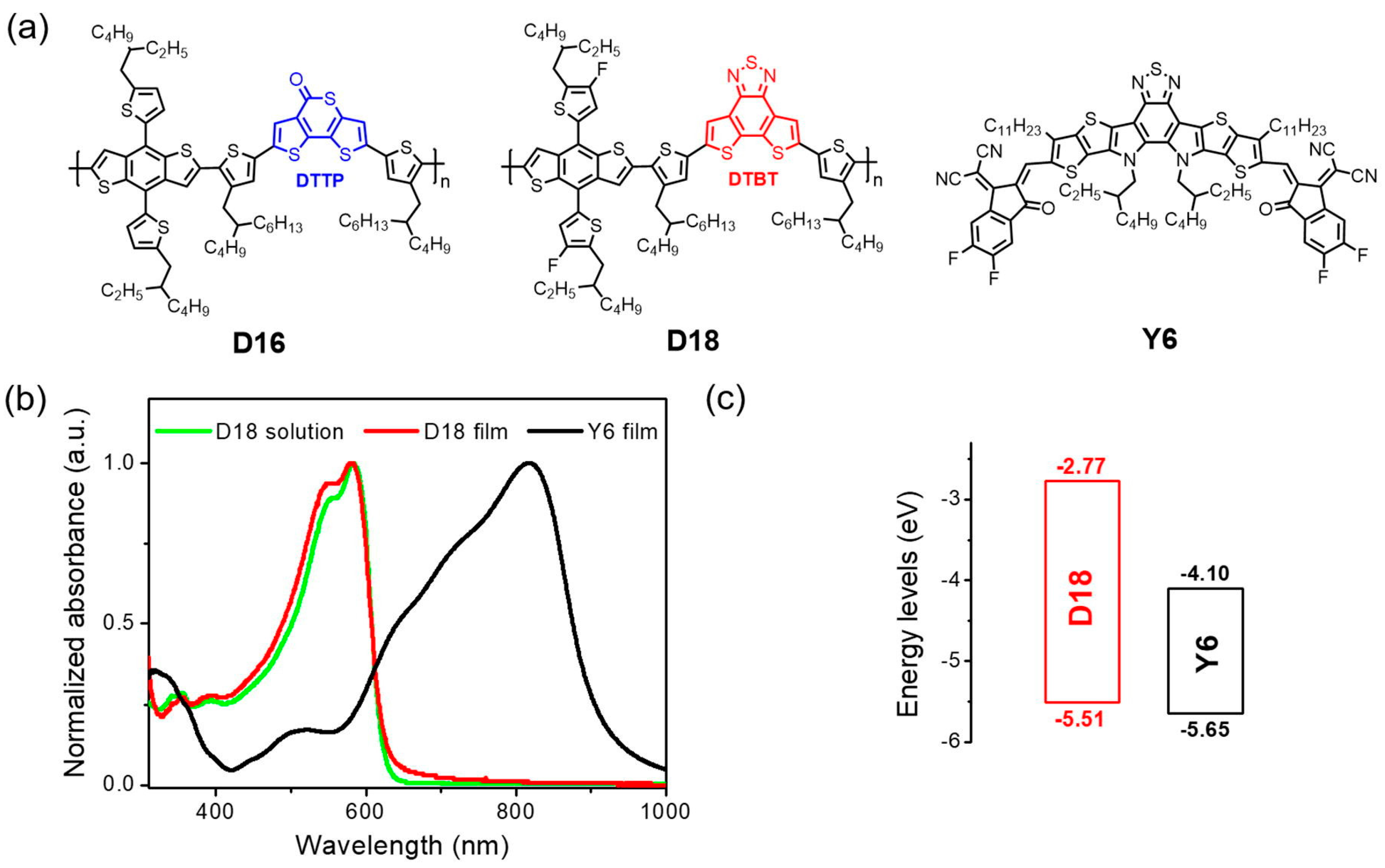
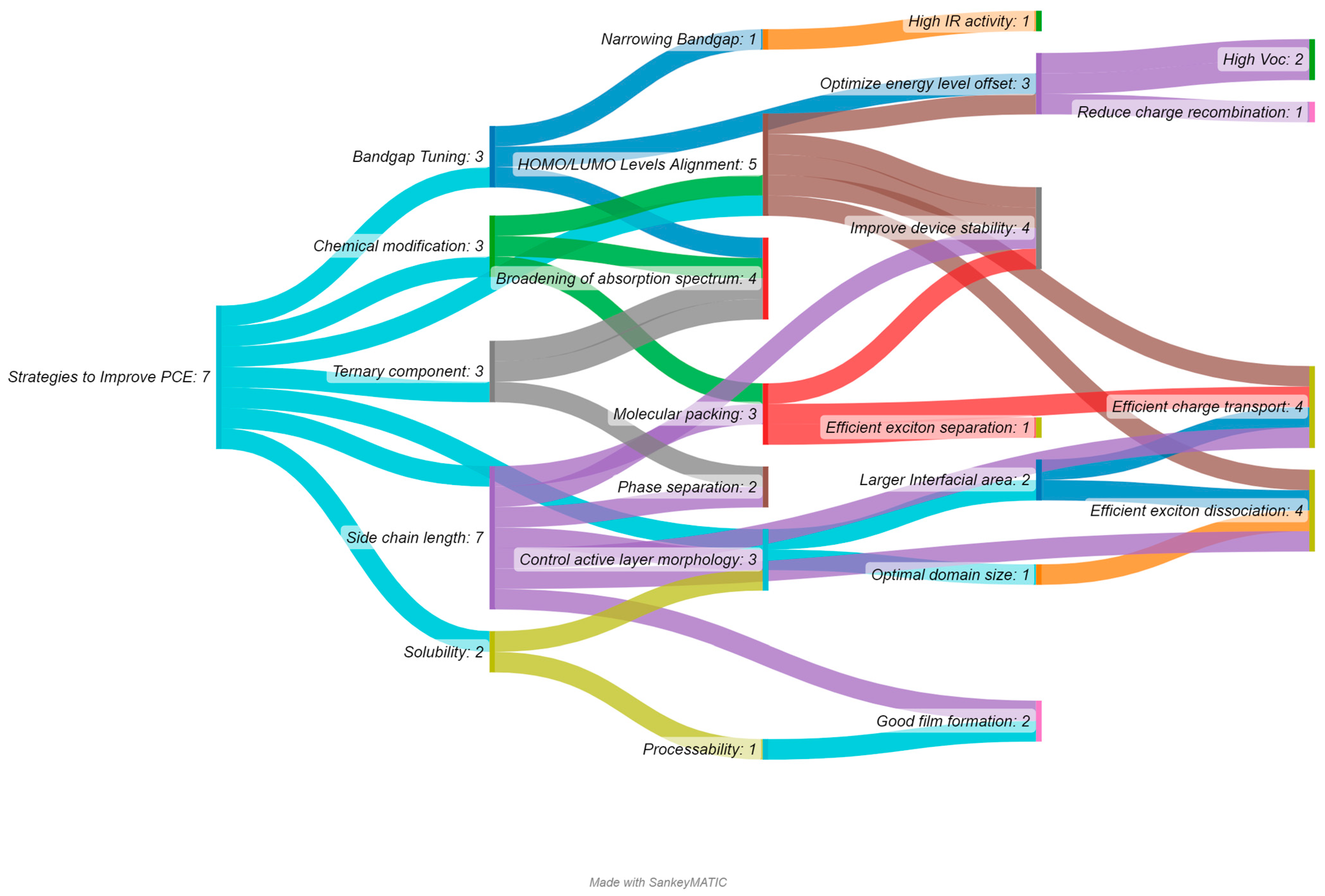
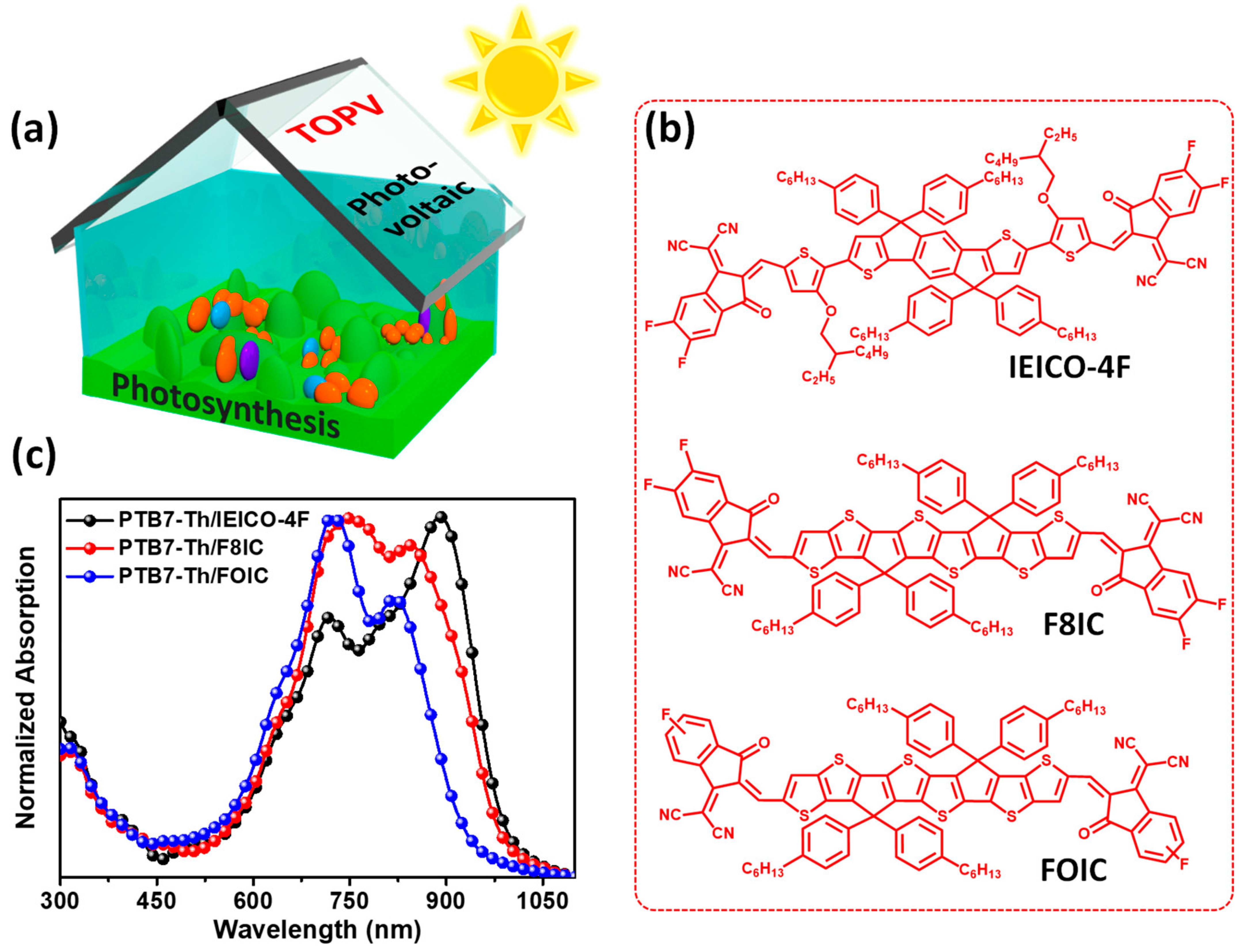

Disclaimer/Publisher’s Note: The statements, opinions and data contained in all publications are solely those of the individual author(s) and contributor(s) and not of MDPI and/or the editor(s). MDPI and/or the editor(s) disclaim responsibility for any injury to people or property resulting from any ideas, methods, instructions or products referred to in the content. |
© 2023 by the authors. Licensee MDPI, Basel, Switzerland. This article is an open access article distributed under the terms and conditions of the Creative Commons Attribution (CC BY) license (https://creativecommons.org/licenses/by/4.0/).
Share and Cite
Ansari, M.A.; Ciampi, G.; Sibilio, S. Tackling Efficiency Challenges and Exploring Greenhouse-Integrated Organic Photovoltaics. Energies 2023, 16, 6076. https://doi.org/10.3390/en16166076
Ansari MA, Ciampi G, Sibilio S. Tackling Efficiency Challenges and Exploring Greenhouse-Integrated Organic Photovoltaics. Energies. 2023; 16(16):6076. https://doi.org/10.3390/en16166076
Chicago/Turabian StyleAnsari, Muhammad Azhar, Giovanni Ciampi, and Sergio Sibilio. 2023. "Tackling Efficiency Challenges and Exploring Greenhouse-Integrated Organic Photovoltaics" Energies 16, no. 16: 6076. https://doi.org/10.3390/en16166076
APA StyleAnsari, M. A., Ciampi, G., & Sibilio, S. (2023). Tackling Efficiency Challenges and Exploring Greenhouse-Integrated Organic Photovoltaics. Energies, 16(16), 6076. https://doi.org/10.3390/en16166076








